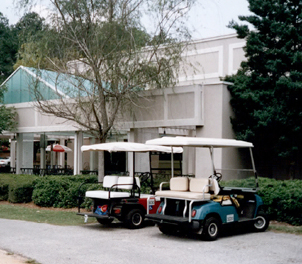The Peachtree City Fire Department recently reported another incident of a household carbon monoxide detector activating, not due to the presence of carbon monoxide, but due to the presence of potentially explosive hydrogen gas in the home due to overcharging of a golf cart near the heating and air conditioning system.
This may come as a surprise to some golf cart owners who may have purchased the cart secondhand and not received a manual for the cart and charger.
One EZGo manual had the following warning: “To prevent battery explosion that could result in severe personal injury or death, keep all smoking materials, open flames or sparks away from batteries. Hydrogen gas is formed when charging batteries. Do not charge batteries without adequate ventilation. A 4-percent concentration of hydrogen gas is explosive. Be sure that the key switch is off and all electrical accessories are turned off before starting work on the vehicle.”
A Club Car manual had a similar warning: “Danger! Batteries emit hydrogen while being charged. Hydrogen is an explosive gas. If the vehicle is equipped with a weatherproof enclosure, it should be unzipped and pulled back while batteries are being charge. This is to avoid the accumulation of hydrogen gas inside the enclosure. The charging area must be ventilated. Hydrogen levels in the air must never exceed 2 percent. The total volume of air in the building must be changed five times per hour. Exhaust fans should be located at the highest point of the roof. Contact a local HVAC engineer.”
The US Fire Administration has a paper published by The Villages (Florida) Public Safety Department on the phenomenon athttp://www.usfa.fema.gov/pdf/efop/efo27803.pdf, but the safety recommendations for golf cart owners include:
· Always keep flames, matches, lighters, cigarettes, or other ignition sources away from the batteries.
· DO NOT put flammable material under the golf cart when charger
· Always plug the charger into an electrical outlet AFTER all connections have been made.
· Charge battery with caps in place. DO NOT pry caps off sealed batteries.
· NEVER charge a golf cart when you are not home to monitor the charging process
· All battery charging should be conducted in a well-ventilated area – open garage doors when charging the golf cart inside.
· NEVER charge golf cart batteries in a closed-in or restricted area.
· Avoid overcharging batteries – non-automatic (manual) battery charger models can overcharge a battery if left connected for an extended period of time, resulting in loss of water and the creation of hydrogen gas.
If you have questions, look online for instructions related to your particular cart and charger brand, or contact a local dealer for assistance.













Leave a Comment
You must be logged in to post a comment.